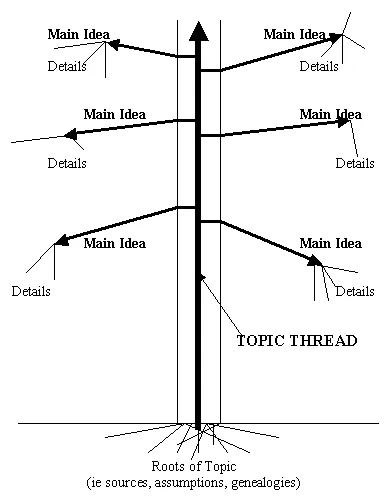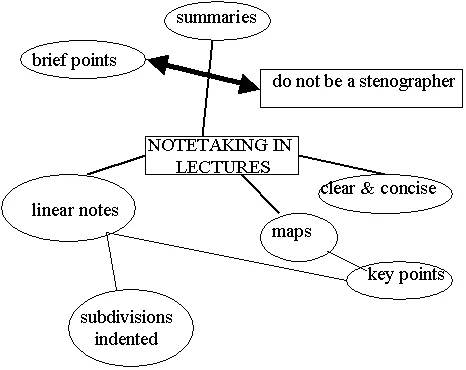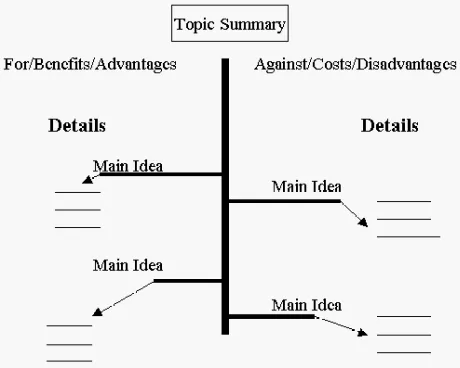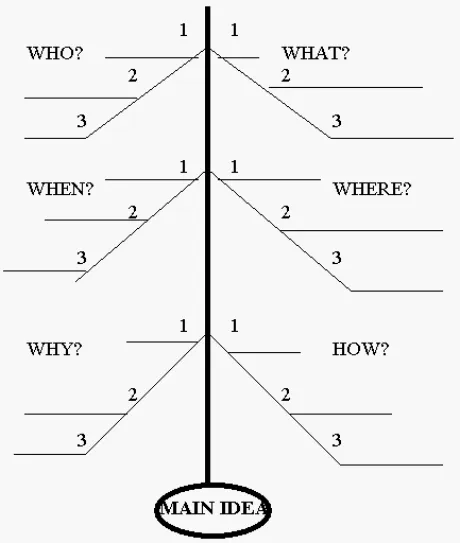One of the most valuable skills you need to develop at university is the ability to make notes effectively.
Good skills in taking and making notes will help you, as an active learner, to organise, categorise and recall information you can use when completing assignments or revising for exams. You can experiment with different strategies to find those which best suit your purpose and learning style.
You will find information here about taking notes during lectures and making notes after lectures, as well as from written texts. You will also learn about different techniques such as paraphrasing, annotation and diagrams. Some examples of different layouts you can use to organise your notes are available for you to explore.
Download this summary sheet for your own records.
Effective note making
Effective note makers are efficient learners. Effective note making is a skill that each person develops over time and with practice to suit their own style of working.
You will find some ideas to help you start on this path in this section.
Effective note makers
Effective note makers:
- can recognise the main ideas
- know which information is relevant to their purpose
- have developed a system that works for them
- can keep it brief and may also use visual diagrams/mindmaps/flowcharts
- mostly use their own words (as well as specialist words)
- record details of the source (bibliographic information such as author, date etc.)
- capture the ideas and thoughts that come to mind as they listen or read. This could be how it relates to an assignment and how they might use it, questions to follow up, or critical comments.
Helpful note making tips
Do
- Practice! Try taking brief notes from a television show you are watching, (e.g. a news item; short documentary), or from a short magazine article.
- Translate information into your own words (paraphrase) and summarise
- Record the bibliographic details of the source
- Organise notes in some form (it could be as outlines, flowcharts, diagrams, lists, column styles)
- Review your notes while the text or lecture is still fresh in your memory. Fill in any gaps you see or further thoughts.
- Try other methods to record your notes such as recording your voice or typing on a laptop
- Research note taking skills and experiment to develop a system that works for you!
Don’t
- Don’t try to write every word – select the major points and important information (especially if you are taking notes in a lecture)
- Don’t write complete sentences, streamline with abbreviations and symbols, organise – leave out the small connecting words (such as was, the, this).
How to take notes from...
Lectures
During the lecture
What you decide to note, and in how much detail, will depend to some extent, on your subject and what you need the notes for.
If the information in the lecture is not available anywhere else, or very difficult to obtain from other sources, then your notes will need to be as detailed as possible.
However if the information is readily available in books or journals (especially a set textbook for the subject), then you should focus on the points or issues that are highlighted by the lecturer.
There are some common features that you might need to note down:
- main points as emphasised by the lecturer
- topic specific terms, phrases and key words
- definitions
- examples
- diagrams
- formulae (and their derivations if appropriate)
- calculations
- relevant questions and answers.
After the lecture
Immediately after the lecture (or as soon as possible and certainly within twenty-four hours) review your notes. This will enable you to:
- identify any gaps in the information and add in any new information that you might have thought of since the lecture
- formulate questions that need further research
- highlight key points
- add relevant references and link them to the main points of the lecture.
Storing your notes
Store your notes in a loose-leaf folder, or a ring binder, so that you can move the pages around as well as add any new material such as handouts and other reference matter.
Regular revision
It is a good idea to revise your notes on a regular, ongoing basis, say for five to ten minutes once a week. Each time you skim through your notes the material will become a little more firmly embedded in your memory.
Textbooks
In most subjects, books and scholarly journals will provide the largest source of material for your notes.
What you decide to note, and the amount of detail will depend, to some extent, on your purpose for taking notes. However, there are some common features that you might wish to include:
- main points and relevant supporting details
- topic specific terms, phrases and key words
- definitions
- diagrams
- formulae (and their derivations if appropriate)
- calculations
- quotes.
Note making strategies
Planning how to go about taking and making notes involves thinking about techniques, tools, layouts and how you will use your notes. There are also some issues to consider such as permission to make audio recordings of lectures or to photograph slide presentations.
There are many different ways to take and make notes and some tools you may want to try, bearing in mind copyright issues. Thinking about how your notes can be used for revision and for writing your assignments is also important. Using abbreviations for common words will save you time so you can focus on essential ideas and information.
Techniques
Annotation
This involves you adding comments to a text that explain or critique what you have read. These can be written in the margins and may accompany words you have highlighted to identify key information. Of course, this would not be on borrowed texts!
Diagrams
They are a more visual form of taking notes. They could be mind-maps, charts, tables, graphs, or perhaps a drawing to capture a process or cycle for example.
Paraphrasing
This means expressing the ideas and information of others in your own words. Transforming the original source material helps you to understand it.
Summaries
And finally, summaries are focused on the main points of the source material so they are a shorter overview.
Tools
Pens, pencils, coloured highlighters and paper note pads are familiar tools for hand written notes. However, there are other effective tools for recording lecture material and for making notes electronically on a computer, tablet, iPad or smartphone for example. A variety of note-taking software and mobile applications are also available.
It can be useful to audio record lectures for later review and follow-up note making. Digital recorders are increasingly affordable and files can be transferred to a computer. Many mobile phones also enable audio recording. Mobile devices such as iPads and other tablets and smartpens are becoming popular options.
Note that you have sought the permission of the lecturer to make such digital recordings.
Issues
Intellectual copyright is a crucial issue to consider when recording audio or photographing presentation slides in lectures.
You must have the permission of the lecturer to record these. Some lecturers may provide students with a copy of their lecture and/or presentation slides on their unit site or by request.
Using notes for revision
Your notes are a key part of your revision strategies when preparing for exams, or indeed, for preparing for active, informed participation in tutorials and when researching for and writing your assignments. Organising and reviewing your notes can also help you make connections between individual ideas and gain an overview of the whole subject.
You will need to revisit and work on the notes you have taken throughout the semester.
- Organise notes in a logical way so you can find important information quickly.
- Read them again, highlighting key words and ideas.
- Summarise your notes to help remember ideas and information – your goal now is to minimise them to serve as a memory aid.
- Consider creating mindmaps or brief outlines to summarise.
Remember, revision is best done throughout the semester, not just when exams are scheduled. Time management is very important as your semester plan should include exam preparation and dates, supported by specific weekly plans for the week leading up to and during your exams.
Abbreviations for making notes
Whichever note-making layout you choose to use, you may find it useful to use abbreviations and shortened versions of commonly used words. This will help you save time with writing so that you can concentrate on noting the essential points or ideas. Some common abbreviations are listed below.
| About, regarding, concerning | re |
| Against, opposite, versus | vs |
| Agree | ☺ |
| And | &, + |
| And others | et al |
| And so on, so forth | etc |
| Approximately, roughly, round about | ≈ |
| At | @ |
| Because | ∵ |
| Before | b4 |
| Can't, couldn't | cx |
| Change | Δ |
| Characteristics | chx |
| Confused, clarify | ? |
| Confused totally | ???!!! |
| Copyright | © |
| Definition | defn |
| Don't, does not | dx |
| Down, declining, decreasing | ↓ |
| Each way | ↔ |
| Equal to or greater than | ≥ |
| Equal to or less than | ≤ |
| Especially | ≡ |
| Example | eg |
| Frequency | fr |
| Greater than | > |
| Important | * |
| Infinity, forever, always | ∞ |
| Less than | < |
| Man/men, male(s) | ♀ |
| Member of | ∈ |
| Micro | µ |
| Negative, bad, not | — |
| Necessary, necessarily | □ |
| Not | nx or — |
| Not a member of | ∉ |
| Note | nb |
| Not the same as, does not equal | ≠ |
| Number | # |
| Parallel | ‖ |
| Percent | % |
| Plus or minus | ± |
| Positive, good, plus, in addition | + |
| Possibly, possible | ♢ |
| Same as, equals, identical | = |
| Should be | s/b |
| Sum of, collectively | ∑ |
| Therefore | ∴ |
| That is | ie |
| Unequal, not the same as | ≠ |
| Up, rising, increasing | ↑ |
| Very important | ** |
| With | w/ or c |
| Without | w/o |
| Woman/women, female(s) | ♀ |
Note layouts
There are many ways you can lay out your notes. Some common approaches are demonstrated in this section: linear notes, key word trees, mind maps, networks and the herringbone technique. Links to other ideas for layouts, including the Cornell Method, are also provided.
Linear notes
Taking notes in a linear or sequential fashion is probably the most common way of laying out your notes. A wide left-hand margin is used so that you can add material to your notes at a later date.
| Details of lecture, book or article. | Notes |
|---|---|
Wide left hand margin. Approximately one third of your page. This allows you to add material either
| A. MAJOR TOPIC
B. MAJOR TOPIC |
Keyword tree
Mind map
In this style of notetaking the information is represented in a diagrammatical form. Many different types of diagrams can be used such as key word trees, networks, and herringbone techniques.
As a general rule the main idea or topic is written in the centre of the page (or in a prominent position) with key points added around it in a cluster fashion branching out from the central idea.
Mind maps are extremely useful ways of organising ideas. However, you are restricted to using key words. This requires you to be concise but it can be difficult if there is a large bulk of information and it cannot easily be condensed.
Mind maps are also very effective in helping you organise material when you are planning an essay outline.
Networks
This basically makes use of a slash pattern to organise ideas. It is especially useful if you are trying to map out the ideas in a debate or controversy. It enable opposing ideas to be mapped e.g. pros/cons, costs/benefits, advantages/disadvantages, and so on.
Herringbone technique
The herringbone technique, so-named because it resembles a fish skeleton, is useful for analysing a single idea.
You ask of the main idea Who?, What?, When?, Where?, Why?, and How? In so doing you are able to represent the key idea and aspects of its supporting data.
Three column approach
This example comes from Monash University, Language and Learning Online, and is part of an excellent interactive resource on note making.
Organising notes
How to organise your notes
You may have explored some note layouts you can use to record, review and annotate what you read and hear as part of your learning, but it is also important to organise and store your notes effectively for easy access.
Useful tips
- Use a separate file for each subject area
- Use file dividers to separate major topics
- Use a separate page for each minor topic
- Label files and dividers clearly
- Number and label pages so you can find and re-file them quickly
- Keep an updated contents page at the front of each file.
If you are making notes electronically, either by creating documents or audio recordings for example, you also need to manage your digital media.
- Create a separate digital folder for each subject area
- Create separate folders within the subject folder for major topics
- Create separate documents saved in the appropriate folder for each minor topic
- Name your folders and files meaningfully and logically
- Include page numbers and document labels in headers and/or footers.
Find more information about managing and protecting your work in Managing your studies.
We value your opinion. Please click on the button to share your feedback on these materials. |
Did you know CDU Language and Learning Advisors offer a range of study support options?
https://www.cdu.edu.au/library/language-and-learning-support





